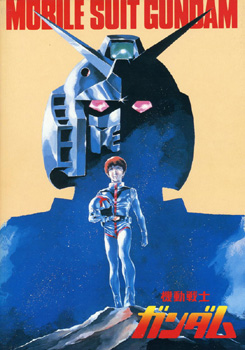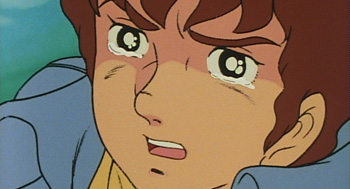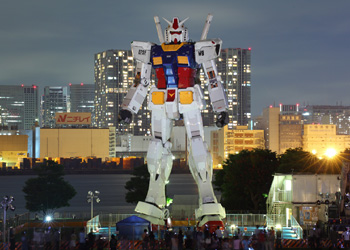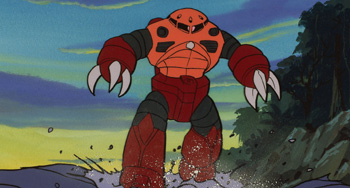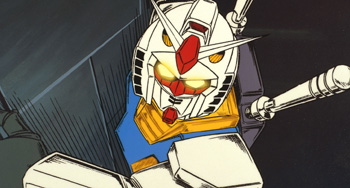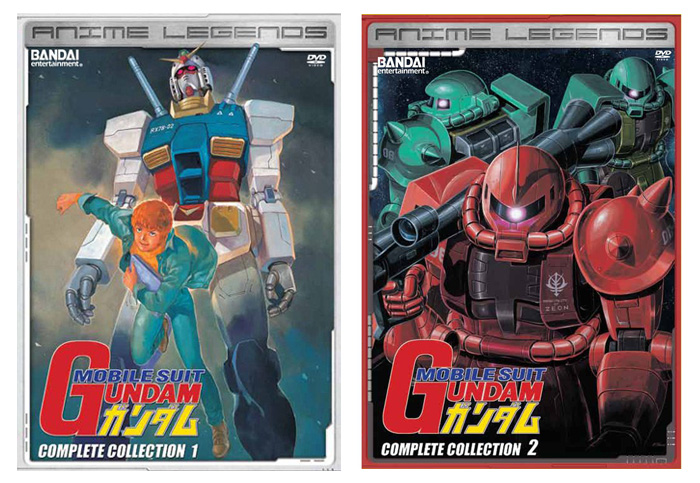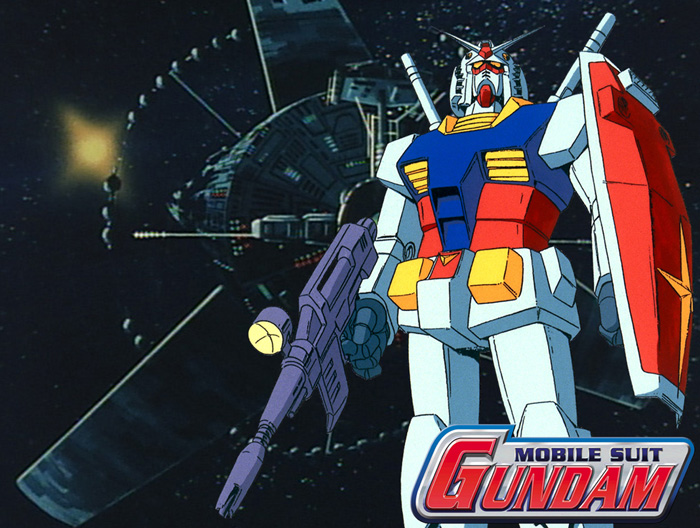 An enduring franchise began in 1979 with the first MOBILE SUIT GUNDAM anime series. Image courtesy of Madman Entertainment. © Sotsu, Sunrise
An enduring franchise began in 1979 with the first MOBILE SUIT GUNDAM anime series. Image courtesy of Madman Entertainment. © Sotsu, SunriseAuthor: Andrew Nguyen Source: Bandai Entertainment, Madman Entertainment Official Site: gundam.jp (Japan), gundamofficial.com (US)
During the 1970s, most Japanese animation that dealt with giant robots (also called mecha) was mainly of the super-robot/superhero variety. However, in April 1979 -- almost two years after the release of STAR WARS in the US -- a veteran Japanese animation director by the name of Yoshiyuki Tomino created, with assistance from the Japanese animation studio Sunrise, a new show called MOBILE SUIT GUNDAM (????????, Kidoo Senshi Gundamu). Two other principal players in the show’s production were character designer Yoshikazu Yasuhiko and mechanical designer Kunio Okawara. At first, it seemed that GUNDAM would follow the standard format of most mecha shows at the time, but differences in comparison to its predecessors were soon apparent. Chief amongst them were the giant robots being actual military weapons of war. In addition, most if not all of the characters had complex backgrounds and characteristics while the opposing organizations were capable of both good and evil, resulting in diverging opinions amongst the audience. When the show first premiered, it had a planned episode count of 52 episodes. However, the poor ratings persuaded the broadcast studio to cut down on the number of episodes to 39 and eventually cancel the show. Fortunately, its staff managed to increase the episode count to 43 while the show underwent changes. Once it ended on January 26, 1980 and headed into reruns, the show took off in a manner that often invites comparisons to that of the original STAR TREK. MOBILE SUIT GUNDAM’s popularity further strengthened when Sunrise released a movie trilogy based on the series from 1981 to 1982 to enormous success. The movie trilogy re-arranged or eliminated several events in the TV series while further removing some of the remaining super-robot elements. In the aftermath of the TV series, Bandai released related Gundam merchandise in the form of plastic models (later known as Gunpla), which became instantly popular and helped fuel the popularity of the franchise as a whole. Although it would take five years, the success of the Gunpla product lines virtually assured a sequel, which appeared in the form of MOBILE SUIT ZETA GUNDAM (?????????, Kidoo Senshi Zeta Gundamu) in 1985 with the production crew and most of the cast from the original series returning to participate. The series has remained exceptionally popular in its home country and in multiple home entertainment formats (VHS, LDs, etc). Even so, it took a long time for the original series to make the transition to the DVD format due to the deterioration of the source material. The movie trilogy was the first to arrive as part of the 20th anniversary celebrations of the original series with most of the cast returning to their roles and new actors assuming the roles of characters whose voice actors were unavailable. Eight years would pass until the original TV series arrived on the DVDs in Japan in 2007 due to the passing of actors who played several key characters. The volume of sales for GUNDAM has been outstanding.
Story
78 years before the beginning of the series, in an attempt to relieve the enormous population problem on Earth, humanity truly began to colonize the stars. Because of this transition, humanity adapted a new calendar timeline called the Universal Century (UC). However, some remained on Earth while forcing the rest to inhabit circular metal structures called colony cylinders, which used the Island 3 cylinder type advocated by Gerald K. O’Neil. Humanity constructed many of these cylinders in clusters surrounding the Earth and the moon with an individual colony cylinder containing millions of people.
Eventually frustrations between the people in these sides (called spacenoids) started to mount, particularly as Side 3, a colony cluster that was the farthest from the Earth, eventually seceded and formed its own independent entity, under the name of the Republic of Zeon, named after its leader, Zeon Zum Deikun who advocated independence for all those who live in space. However, Deikun mysteriously died and one of his closest supporters, Degwin Sodo Zabi assumed leadership. He and his family, particularly his eldest son Gihren Zabi, began preparations to transform Zeon from a Republic into a military dictatorship, named the Principality of Zeon, to take on the Earth Federation. Those plans came to fruition three minutes after midnight on January 3, UC 0079 as the Principality of Zeon declared war on the Earth Federation in the name of independence for spacenoids. Almost instantly after the speech ended, the One Year War began as the Zeon military launched an all-out assault on the three nearest colony Sides. Using new humanoid weapons called mobile suits the Zeon rapidly overwhelmed the numerically larger Earth Federation forces. After annihilating the military forces as well as exterminating the civilians with horrendous mass use of nuclear and biological weapons, the Zeon attempted to force the Earth Federation’s surrender by dropping the colony cylinders onto the Earth. The first attempt at a colony drop narrowly failed while the Earth Federation’s entire space fleet nearly sacrificed itself to stop the second drop. In the aftermath, it seemed that Zeon had triumphed. However, when a high level Federation General escapes from the custody of the Zeons, the Earth Federation learned the true state of its enemy and their will to resist is strengthened.
After the two sides reached a treaty, which established rules and guidelines for the war, the Principality of Zeon invades Earth to seize resources needed to survive in a war of attrition. The war turns into a stalemate until September when a Zeon strike force under the command of Captain Char Aznable, a legendary ace known as the Red Comet, infiltrates the neutral colony at Side 7 and discovers the Earth Federation developing its own mobile suits. They attempt to prevent the delivery of those mobile suits by launching an attack with three MS-06F Zaku IIs, the backbone of the Zeon military. In the midst of the attack, a civilian teenager and engineering genius named Amuro Ray has his life changed forever as he stumbles into one of the suits, called the RX-78-2 Gundam and takes it into combat against the Zeon strike force, doing exceptionally well as he kills one of the Zakus that attacked his home. Joining others on a Federation mobile suit carrier called White Base, he and the Gundam gradually becomes one of the most decisive factors in the war. Furthermore, Amuro begins to develop abilities that differentiate him from most ordinary humans as he and Char Aznable develop one of the most legendary rivalries in Japanese mecha anime.
Legacy
Today, MOBILE SUIT GUNDAM is a landmark series in Japan as it launched the Real Robot Genre with similar shows such as COMBAT ARMOR DOUGRAM, ARMORED TROOPERS VOTOMS, and THE SUPER DIMENSIONAL FORTRESS MACROSS. The titular mecha, the RX-78-2 Gundam is the metaseries` most recognizable icon and it has appeared in all Gunpla model lines.
During the celebration of the 30th anniversary of the series, Sunrise constructed a 1/1 scale of the RX-78-2 Gundam in Odaiba which was later taken down and then reconstructed at Shizouka Prefecture where the main Gunpla factory is located. Although finally disassembled in March 2011, parts of the statue have reappeared in Odaiba in August and the statue itself which will be displayed in Odaiba from Spring 2012 to March 2013. In the case of the characters, Char Aznable has become the most recognized in the Gundam metaseries. Often many have stated that Char Aznable is as recognizable in Japan as Darth Vader of STAR WARS and Spock of STAR TREK is recognizable in the US. Furthermore, there have been multiple retellings of the story in other formats such as video games, books and manga. Also in sequels as well as other mecha shows that came after, the storylines have taken both story and mecha design aspects from the original series. Even two of the three main producers of the original series wrote retellings of GUNDAM, with Yoshiyuki Tomino writing a trilogy of novels during the airing of the TV series that explained some of his potential plans for the series as well as provide backstory and additional details on the ideals voiced by the characters in the story. Character designer Yoshikazu Yasuhiko has written the manga Mobile Suit Gundam: The Origin, which is an attempt to provide an enormous amount of backstory -- from the writer’s point of view -- to nearly all the characters while also re-arranging events in the show as well. The manga, serialized in Gundam Ace magazine since 2002, recently finished in Japan and some of the issues were released in the US during the early to mid-2000 from Viz Comics. Recently, Sunrise announced that it would create a new animated project based on the recently completed manga.
Arrival in America
Ironically, MOBILE SUIT GUNDAM first appeared on American shores in the form of the novel trilogy, which underwent translation by Frederik L. Schodt for Ballantine Books in 1990 and 1991. Without a unified translation of all the names of the character and mecha that appear in the story, Schodt had to improvise as best he could on the translation from Japanese to English. With the increased popularity of the Gundam metaseries around the globe throughout the years, the publishing firm Stone Bridge Press negotiated with Ballantine Books and Bandai/Sunrise to re-release the novel trilogy in a single volume format with the Japanese companies providing a unified list of names for the characters and mecha. Schodt provided the translation again and he received help from American GUNDAM series expert Mark Simmons. Stone Bridge Press released a new edition of the novel trilogy Mobile Suit Gundam: Awakening, Escalation, Confrontation in April 2012. MOBILE SUIT GUNDAM eventually appeared in America in an animated format with the release of the English versions of the movie trilogy on VHS in 1998. Later in the aftermath of the phenomenal success of MOBILE SUIT GUNDAM WING (?????????W(????), Shin Kidoo Senki Gandamu Uingu) in 2000, Bandai pushed to release the original MOBILE SUIT GUNDAM TV series in America. Airing on Cartoon Network in July of 2001, it unfortunately did not do well and disappeared from US television in the aftermath of the 9-11 attacks. The show reappeared on Cartoon Network’s Adult Swim block in 2002 but the network again pulled it from the air due to low ratings.
Around the same time, DVDs of both the TV series and the movie trilogy appeared in US stores with the movie trilogy only in its original Japanese language and the TV series only in the English dubbed language as the Japanese audio from the TV series was in poor condition at the time. Another interesting fact is that the US DVD releases of the TV series are missing an episode. There is speculation of why such an event happened. In May 2010, Bandai re-released the movie trilogy in the US as part of its Anime Legends product line. Later in in that year, it announced plans to reissue the TV series in the form of two box sets. This time the American DVDs would have the redone Japanese language track as an option. Those plans have come to fruition with the release of the first box set in the US on September 13, 2011 with the second box set released in February 7, 2012. In addition, the streaming website Crunchyroll has the English dubbed version of the show on its site.
MOBILE SUIT GUNDAM TV Series
Japanese Production Animation Production: Sunrise, Sotsu Agency, Nagoya Broadcasting Network, Licensed by: Bandai Entertainment Production Crew Chief Director: Yoshiyuki Tomino Chief Character Designer: Yoshikazu Yasuhiko Chief Mechanical Designer: Kunio Okawara Original Story: Hajime Yatate, Yoshiyuki Tomino Music: Takeo Watanabe, Yuji Matsuyama Art Director: Mitsuki Nakamura Sound Director: Noriyoshi Matsuura Director of Photography: Akio Saitô, Takafumi Hirata Producer: Hobuyuki Okuma, Wataru Sekioka, Yasuo Shibue Cast Amuro Ray: Tohru Furuya Char Aznable: Shuuichi Ikeda Bright Noa: Hirotaka Suzuoki Sayla Mass: You Inoue Lalah Sune: Keiko Han Hayato Kobayashi: Kiyonobu Suzuki Kai Shiden: Toshio Furukawa Mirai Yashima: Fuyumi Shiraishi Fraw Bow: Rumiko Ukai Gihren Zabi: Banjo Ginga Kycilia Zabi: Mami Koyama Dozle Zabi: Daisuke Gori, Garma Zabi: Katsuji Mori Degwin Sodo Zabi: Yuzuru Fujimoto Ramba Ral: Masahi Hirose M’quve: Kaneto Shiozawa Matilda Adjan: Keiko Toda General Revil: Masaru Ikeda Slegger Law: Tessho Genda English Version Staff ADR Production: The Ocean Group Licensed by: Bandai Entertainment Translation: Paul Baldwin Voice Direction: Amiel Gladstone Executive Producer: Takayuki Hoshii, Ken Iyadomi Producer: Eric P. Sherman, Nobuo Masuda Creative Consultant: Lloyd Fonvielle ADR Scriptwriters: Robert Choimak Production Coordinators: Mayumi Yuba, Dianna Gage, Patricia Murray Script Consultants: Mark Simmons, AC Enterprise Script: Kathleen Westlake, Robert Chomiak Casting: Rob Bakewell Cast Amuro Ray: Brad Swaile Char Aznable: Michael Kopsa Bright Noa: Chris Kalhoon Sayla Mass: Aliana Burnett Lalah Sune: Willow Johnson Hayato Kobayashi: Matt Smith Kai Shiden: Richard Cox Mirai Yashima: Cathy Weseluck Fraw Bow: Kristie Mardsen Gihren Zabi: Hiro Kanagawa Kycilia Zabi: Michelle Porter Dozle Zabi: French Tickner Garma Zabi: Brian Dobson Degwin Sodo Zabi: Chris Schneider Ramba Ral: John Payne Matilda Adjan: Sylvia Zaradic General Revil: Michael Dobson Slegger Law: Bill Mondy
MOBILE SUIT GUNDAM Movie Trilogy
MOBILE SUIT GUNDAM I (1981) MOBILE SUIT GUNDAM II: SOLDIERS OF SORROW (1981) MOBILE SUIT GUNDAM III: ENCOUNTERS IN SPACE (1982) Animation Production: Sunrise Licensed by: Bandai Entertainment Japanese Production Staff Chief Director: Yoshiyuki Tomino Director: Ryoji Fujiwara Chief Character Designer and Animation Supervisor: Yoshikazu Yasuhiko Chief Mechanical Designer: Kunio Okawara Original Story: Hajime Yatate, Yoshiyuki Tomino Music: Takeo Watanabe, Hiroshi Matsuyama Screenplay: Ken`ichi Matsuzaki, Hiroyuki Hoshiyama, Yoshihisa Araki, Masaru Yamamoto Art Director: Mitsuki Nakamura Audio Director: Yota Tsuruoka Executive Producer: Eiji Yamaura, Masanori Ito, Yoshinori Kishimoto Producer: Masami Iwasaki, Masuo Ueda, Takayuki Yoshii, Yasuo Shibue Co-Producer: Satoshi Kubo Cast Amuro Ray: Tohru Furuya Char Aznable: Shuuichi Ikeda Bright Noa: Hirotaka Suzuoki Sayla Mass: You Inoue Lalah Sune: Keiko Han Hayato Kobayashi: Kiyonobu Suzuki Kai Shiden: Toshio Furukawa Mirai Yashima: Fuyumi Shiraishi Fraw Bow: Rumiko Ukai Gihren Zabi: Banjo Ginga Kycilia Zabi: Mami Koyama Dozle Zabi: Daisuke Gori, Tessho Genda (special edition) Garma Zabi: Katsuji Mori Degwin Sodo Zabi: Ichiro Nagai, Hidekatsu Shibata (special edition) Ramba Ral: Masahi Hirose M’quve: Kaneto Shiozawa, Masahiko Tanaka (special edition) Matilda Adjan: Keiko Toda General Revil: Masaru Ikeda, Katsunosuke Hori (special edition) Slegger Law: English Production Staff Director: Doug Stone Translation: Neil Nadelman ADR Script: Robert Barron Executive producer: Ken Iyadomi Producer: Haruyo Kanesaku, Yasou Miyakawa,Yutaka Maseba ADR Recording: Brian Geer Associate producer: Nobu Yamamoto Co-Producer: Kimi Matsuki Editing: Les Arenson, Robert Davies Re-Recording Mixing: Jeff Mar Sound Editor: Steve Cartwright Studio Management: John Davies Cast Amuro Ray: Michael Lindsy Char Aznable: Steven J. Blum Bright Noa: Wheat St. James Sayla Mass: Olivia Bardeau Lalah Sune: Lia Sargent Hayato Kobayashi: Richard Cansino Kai Shiden: Eddie Frierson Mirai Yashima: Leslie Buhr Fraw Bow: Melissa Fahn Gihren Zabi: Doug Stone Kycilia Zabi: Bambi Darro Dozle Zabi: Peter Spellos Degwin Sodo Zabi: Elliot Reynolds Ramba Ral: Michael McConnohie Matilda Adjan: Mary Elizabeth McGlynn General Revil: Anthony Mozdy
For more information on MOBILE SUIT GUNDAM please see the earlier coverage here on SciFi Japan:
- MOBILE SUIT GUNDAM 00 to Stream on Crunchyroll
- MOBILE SUIT GUNDAM UC (UNICORN)
- MOBILE SUIT ZETA GUNDAM
- MOBILE SUIT GUNDAM 00
- New Edition of Mobile Suit Gundam: Awakening, Escalation, Confrontation


